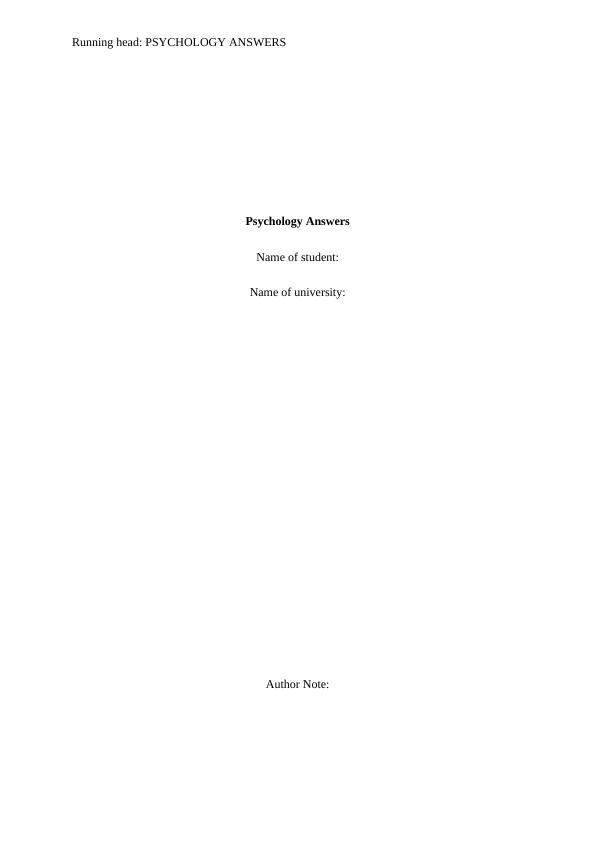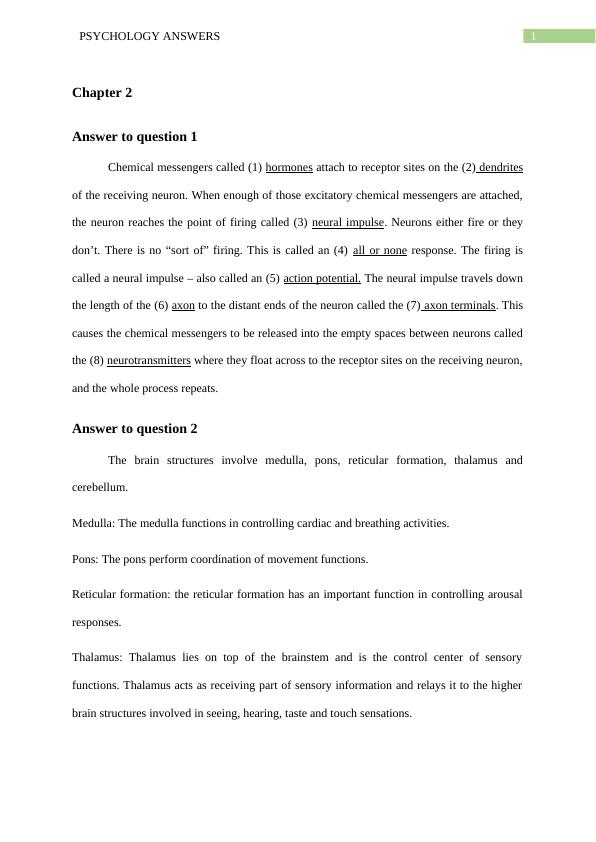Psychology Answers
Added on 2023-04-24
7 Pages1383 Words443 Views
Running head: PSYCHOLOGY ANSWERS
Psychology Answers
Name of student:
Name of university:
Author Note:
Psychology Answers
Name of student:
Name of university:
Author Note:

1PSYCHOLOGY ANSWERS
Chapter 2
Answer to question 1
Chemical messengers called (1) hormones attach to receptor sites on the (2) dendrites
of the receiving neuron. When enough of those excitatory chemical messengers are attached,
the neuron reaches the point of firing called (3) neural impulse. Neurons either fire or they
don’t. There is no “sort of” firing. This is called an (4) all or none response. The firing is
called a neural impulse – also called an (5) action potential. The neural impulse travels down
the length of the (6) axon to the distant ends of the neuron called the (7) axon terminals. This
causes the chemical messengers to be released into the empty spaces between neurons called
the (8) neurotransmitters where they float across to the receptor sites on the receiving neuron,
and the whole process repeats.
Answer to question 2
The brain structures involve medulla, pons, reticular formation, thalamus and
cerebellum.
Medulla: The medulla functions in controlling cardiac and breathing activities.
Pons: The pons perform coordination of movement functions.
Reticular formation: the reticular formation has an important function in controlling arousal
responses.
Thalamus: Thalamus lies on top of the brainstem and is the control center of sensory
functions. Thalamus acts as receiving part of sensory information and relays it to the higher
brain structures involved in seeing, hearing, taste and touch sensations.
Chapter 2
Answer to question 1
Chemical messengers called (1) hormones attach to receptor sites on the (2) dendrites
of the receiving neuron. When enough of those excitatory chemical messengers are attached,
the neuron reaches the point of firing called (3) neural impulse. Neurons either fire or they
don’t. There is no “sort of” firing. This is called an (4) all or none response. The firing is
called a neural impulse – also called an (5) action potential. The neural impulse travels down
the length of the (6) axon to the distant ends of the neuron called the (7) axon terminals. This
causes the chemical messengers to be released into the empty spaces between neurons called
the (8) neurotransmitters where they float across to the receptor sites on the receiving neuron,
and the whole process repeats.
Answer to question 2
The brain structures involve medulla, pons, reticular formation, thalamus and
cerebellum.
Medulla: The medulla functions in controlling cardiac and breathing activities.
Pons: The pons perform coordination of movement functions.
Reticular formation: the reticular formation has an important function in controlling arousal
responses.
Thalamus: Thalamus lies on top of the brainstem and is the control center of sensory
functions. Thalamus acts as receiving part of sensory information and relays it to the higher
brain structures involved in seeing, hearing, taste and touch sensations.

2PSYCHOLOGY ANSWERS
Cerebellum: The cerebellum performs in controlling and coordinating voluntary movements
and balance of body. Storage and processing of memories, judgment roles and controlling
emotions and discriminating between sounds and various textures are the functions dependent
on the cerebellum1.
The limbic system consists of hippocampus, amygdala and hypothalamus.
Hippocampus: It is involved in processing of conscious state memories.
Amygdala: It is involved in fear and aggression responses.
Hypothalamus: Hypothalamus is involved in controlling hunger and thirst, body temperatures
and help to maintain a homeostatic balance.
Answer to question 3
The cerebral cortex consists of frontal lobes, occipital lobe, parietal lobe and temporal
lobe. All of which perform voluntary functions related to cortical areas. The visual cortex of
occipital lobe is involved in interpretation of visual images or information from television.
Primary auditory cortex is involved in interpretation of the auditory in formation from
television and promote comprehending the speech on screen. The temporal lobe is active in
integrating the visual and auditory stimuli from television2. The parietal lobe promotes a
complete view of the entire on screen scenario.
Answer to question 4
Sleep loss or sleep deprivation causes thwarting of energized states of an individual.
Sleep deprivation leads to depressing episodes in an individual and increases the risk of
1 Paxinos, George, and Xu-Feng Huang. Atlas of the human brainstem. Elsevier, 2013.
2 Stuss, Donald T., and Robert T. Knight, eds. Principles of frontal lobe function. Oxford University Press,
2013.
Cerebellum: The cerebellum performs in controlling and coordinating voluntary movements
and balance of body. Storage and processing of memories, judgment roles and controlling
emotions and discriminating between sounds and various textures are the functions dependent
on the cerebellum1.
The limbic system consists of hippocampus, amygdala and hypothalamus.
Hippocampus: It is involved in processing of conscious state memories.
Amygdala: It is involved in fear and aggression responses.
Hypothalamus: Hypothalamus is involved in controlling hunger and thirst, body temperatures
and help to maintain a homeostatic balance.
Answer to question 3
The cerebral cortex consists of frontal lobes, occipital lobe, parietal lobe and temporal
lobe. All of which perform voluntary functions related to cortical areas. The visual cortex of
occipital lobe is involved in interpretation of visual images or information from television.
Primary auditory cortex is involved in interpretation of the auditory in formation from
television and promote comprehending the speech on screen. The temporal lobe is active in
integrating the visual and auditory stimuli from television2. The parietal lobe promotes a
complete view of the entire on screen scenario.
Answer to question 4
Sleep loss or sleep deprivation causes thwarting of energized states of an individual.
Sleep deprivation leads to depressing episodes in an individual and increases the risk of
1 Paxinos, George, and Xu-Feng Huang. Atlas of the human brainstem. Elsevier, 2013.
2 Stuss, Donald T., and Robert T. Knight, eds. Principles of frontal lobe function. Oxford University Press,
2013.

End of preview
Want to access all the pages? Upload your documents or become a member.
Related Documents
Neurological Basis of Alzheimer's Disease - BIO363lg...
|12
|2933
|154
LESSON 2: BIOLOGY AND PSYCHOLOGY September 5-9, 2022.lg...
|14
|411
|49
Psychology Assignment: Human Brainlg...
|10
|3834
|121
